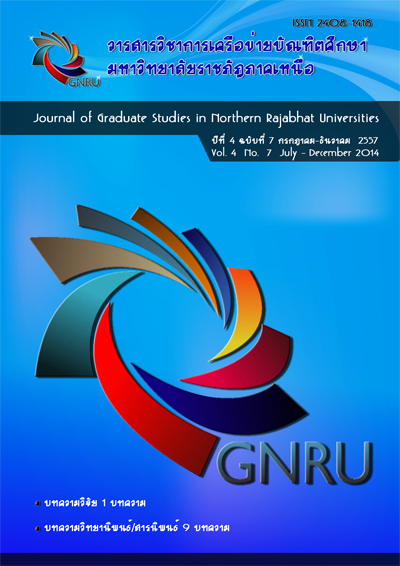การใช้หลักสูตรฝึกอบรม: การพัฒนาศักยภาพอาชีวอนามัยในชุมชน โดยเน้นกระบวนการเรียนรู้แบบมีส่วนร่วม ; The Use of Training Curriculum: The Development of Occupational Health in The Community with an Emphasis on Participatory Learning Process
Main Article Content
Abstract
บทคัดย่อ
การวิจัยในครั้งนี้มีวัตถุประสงค์ เพื่อศึกษาผลการใช้หลักสูตรฝึกอบรมและศึกษาความพึงพอใจของผู้เข้าอบรมที่มีต่อหลักสูตรฝึกอบรม: การพัฒนาศักยภาพอาชีวอนามัยในชุมชน โดยเน้นกระบวนการเรียนรู้แบบมีส่วนร่วมกลุ่มตัวอย่างในการวิจัยในครั้งนี้ คือ อาสาสมัครสาธารณสุข กลุ่มผู้ประกอบอาชีพผู้ทำโครงร่ม ตำบลแม่คือ อำเภอดอยสะเก็ด จังหวัดเชียงใหม่ จำนวน 30 คน โดยสมัครเข้าร่วมอบรมด้วยความสมัครใจ เครื่องมือที่ใช้ในการวิจัย มีดังนี้ 1) แบบทดสอบความรู้ ความเข้าใจ เกี่ยวกับเรื่องการดูแลสุขภาพและเฝ้าระวังโรคจากการประกอบอาชีพและสิ่งแวดล้อม 2) แบบประเมินความเสี่ยงต่อสุขภาพในการทำงานเบื้องต้น 3) แบบติดตามการปรับปรุงสภาพการทำงานสำหรับผู้ทำงานที่บ้านและ 4) แบบประเมินความพึงพอใจต่อการอบรมวิเคราะห์ข้อมูล โดยการหาค่าร้อยละค่าเฉลี่ย () ส่วนเบี่ยงเบนมาตรฐาน (S.D.) และค่า t-test
ผลการวิจัยพบว่า
1. การใช้หลักสูตรฝึกอบรม: การพัฒนาศักยภาพอาชีวอนามัยในชุมชน โดยเน้นกระบวนการเรียนรู้แบบมีส่วนร่วม พบว่า 1) ผู้ฝึกอบรมมีความรู้ ความเข้าใจ เกี่ยวกับเรื่องการดูแลสุขภาพและเฝ้าระวังโรคจากการประกอบอาชีพและสิ่งแวดล้อม หลังฝึกอบรมสูงกว่าก่อนฝึกอบรม อย่างมีนัยสำคัญทางสถิติที่ระดับ .05 2) ผู้ฝึกอบรมมีความเสี่ยงต่อสุขภาพเบื้องต้นโดยภาพรวมลดลงอย่างมีนัยสำคัญทางสถิติที่ระดับ .05 นอกจากนี้ยังพบว่าผู้ฝึกอบรมมีการปรับปรุงสภาพการทำงานหลังฝึกอบรมดีขึ้นอย่างมีนัยสำคัญทางสถิติที่ระดับ .05
2. ผู้ฝึกอบรมมีความพึงพอใจในภาพรวมอยู่ในระดับมากที่สุด ( = 4.63) ในด้านการมีโอกาสได้ปฏิบัติกิจกรรมใหม่เพื่อเรียนรู้เพิ่มขึ้น และได้เรียนรู้แบบมีส่วนร่วมและนำความรู้ที่ได้รับไปใช้ประโยชน์ในชีวิตประจำวันและการประกอบอาชีพ
Abstract
The purposes of this study were to study satisfaction of participants involved in the training. The samples of this study were thirty participants from Mae Kue, Doi Saket’s public healthcare volunteers. They were chosen by purposive sampling method. The instrument used in this study conisited of the following 1) Questionnaire about healthcare and disease preventive measures from occupation and the environment. 2) Survey on preliminary health risks in the work environment. 3) Report on improving work conditions for those who work from home. 4) Survey determining the level of satisfaction of participants involved. The obtained data were analyzed in terms of percentage, mean (), standard deviation (S.D.) and t-test.
The results were as follows:
1. Use of training curriculum: the development of occupational health in the community focusing on Participatory Learning Process found that 1) the knowledge after training was better than before training at .05 level and 2) there were preliminary health risks for participants who has undergone the training significantly decreased in preliminary health risks of participants who had undergone the training at the .05 level. In addition, we have found that participants showed a greater working condition after training at the .05 level.
2. The participants had the highest level of satisfaction with the interactive training ( = 4.63) as they were given the opportunity to learn and applied to their daily life and work routines (= 4.7).


